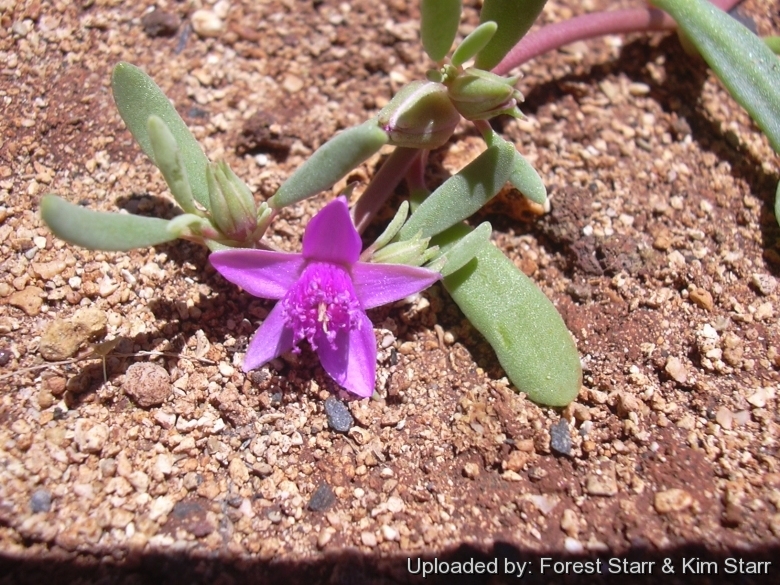
Sesuvium verrucosum Photo by: Forest Starr & Kim Starr
Flower at Kahului, Maui, Hawaii (USA). June 26, 2003.
Origin and Habitat: Sesuvium verrucosam is native to the Americas, where it can be found in the southwestern quadrant of the United States (California, Oregon, Baja California, east to Utah, Kansas, Texas) and northern Mexico, it also occurs in southern Brazil. It is naturalized in the Arabian peninsula (eastern Saudi Arabia, Bahrain) and elsewhere in the world.
Altitude range: 0–1000 metres above sea level
Habitat and ecology: Sesuvium verrucosum a highly salt tolerant succulent halophyte that grows in many types of low-lying saline, semi-saline or alkaline habitats on the coast bordering the mangrove and margins of estuaries but not in tidally inundated or marine habitats, and inland, including salt marshes and other saline wetlands, moist or seasonally dry alkali flats, desert playa lakes, drying desert washes, agricultural areas, waste places, and abandoned fields. It is a less widespread species than the Suaeda depressa and Salicornia rubra salt pan communities. S. verrucosum is one of the most salt tolerant species occurring in inland North America, commonly occurring in pure stands or sometimes associated with Suaeda depressa. It has been reported as a pioneer species in saline soils of Oklahoma by Ortenburger and Bird . In central Kansas it behave like an annual, elsewhere throughout its range it is described as a perennial herb.
Synonyms:
See all synonyms of Sesuvium verrucosum
back
Accepted name in llifle Database:Sesuvium verrucosum Raf.New Fl. (Rafinesque) 4: 16 1836Synonymy: 2
back
Common Names include:
ENGLISH: Western sea-purslane, Verrucose sea-purslane, Sea purslane, Verrucose seapurslane, Western sea purslane, Western-purslane
Description: Sesuvium verrucosumSN|23810]]SN|28896]] known by the common names western sea-purslane and verrucose sea-purslane is a glabrous much-branched succulent herb to c. 30 cm or more high, forming a mat up to two metres wide. The herbage is often red-green, finely verrucose and covered densely in crystalline, hemispherical papillae (bumps). It produces peculiar flower with rose-colored sepals, and no petal. It may behave both like an ephemeral or short-lived perennial. Sesuvium verrucosumSN|23810]]SN|28896]] is widespread and variable.
Stems: Many, finely verrucose, prostrate, not rooting at nodes up to a metre long, radiating from a weak taproot on ephemeral or first-season plants, and from a basal caudex on perennials.
Leaves: Mostly opposite, subsessile to short petioled, narrowly to broadly spathulate, of varying shapes, succulent and thick but conspicuously flattened, 1,5-5 cm long, 2-10 mm wide, papillate with crystalline globules abundant, glabrous, , rounded or acutish at apex, the leaf bases flared and clasping with broadly winged, membranous margins.
Flowers: 8-11 mm in diameter, mostly solitary in the leaf axils, sessile or subsessile (pedicel less than to 2 mm). They have no petals, but the five petal-like sepals that are thick and succulent, (2-)4-6(-10) mm long, generally bright pink to reddish or orange inside, greenish at back, ovate-lanceolate, margins scarious, shallowly hooded, back prolonged into short beak 1-1.5 mm long near apex with a thick, crystalline-verrucose outer surface. At the centre of the flower is a ring of approx 30 stamens around the central ovary. The filaments connate in proximal 1/2, pink or redddish, fleshy (appearing flat or winged when dry), the anthers often bright magenta. Pistil 5-carpellate.Ovary 5-loculed. Styles 5.
Fruit (capsule): About 3-3.5 mm. in diameter, 4-5 mm. high, ovoid-globose, opening by a conical lid and containing 20–40 seeds.
Blooming season: Spring to Autumn (March-Nov.).
Seeds: Dark red-brown to black, reniform-obovoid, markedly broader above the middle, smooth and shiny, 0.8-0.9 x 0.65-0.7 mm, not conspicuously notched. Funiculus persistent.
Similar species: Several names, including Sesuvium sessileSN|23820]]SN|23820]] Persoon, have been applied or misapplied to this species, which can resemble Sesuvium portulacastrumSN|28896]]SN|23810]]. It differs from Sesuvium portulacastrumSN|28896]]SN|23810]] in having sessile or occasionally pedicellate flowers and in lacking roots at stem nodes. Moreover the stems and leaves of S. verrucosum are generally not as thick and succulent as those of S. portulacastrum.
Bibliography: Major references and further lectures
1) Forest & Kim Starr “Sesuvium verrucosum (Verrucose sea purslane)”. Plants of Hawaii. <http://www.starrenvironmental.com>. Downloaded on 20 August 2014.
2) Jim Kenna, United States. Bureau of Land Management. Lakeview District “Warner Wetlands Area of Critical Environmental Concern (ACEC) management plan” U.S. Department of the Interior, Bureau of Land Management, Lakeview District Office, 1990
3) Robert J. Mold “Ecology of Halophytes” Elsevier, 02/Dec/2012
4) Richard Stephen Felger “Flora of the Gran Desierto and Rio Colorado of Northwestern Mexico” University of Arizona Press, 2000
5) Forrest Shreve, Ira Loren Wiggins “Vegetation and Flora of the Sonoran Desert” Volume 1 Stanford University Press, 1964
6) Mandaville “Flora Of Eastern Saudi Arabia” Routledge, 06/Aug/2013
7) Wikipedia contributors. "Sesuvium verrucosum." Wikipedia, The Free Encyclopedia. Wikipedia, The Free Encyclopedia, 4 Jun. 2014. Web. 23 Sep. 2014.
8) CONABIO. “Catálogo taxonómico de especies de México” 1. In Ca. nat. México. CONABIO, México City. 2009.
9) Correll, D. S. & M. C. Johnston. “Man. Vasc. Pl.” Texas i–xv, 1–1881. The University of Texas at Dallas, Richardson.1970.
10) Flora of North America Editorial Committee, “Magnoliophyta: Caryophyllidae” part 1. 4: i–xxiv, 1–559. In Fl. N. Amer.. Oxford University Press, New York. 2003
11) Great Plains Flora Association. “Fl. Great Plains” i–vii, 1–1392. University Press of Kansas, Lawrence.1986
12) Hickman, J. C. Jepson Man. “Higher Pl. Calif.” i–xvii, 1–1400. University of California Press, Berkeley.1993
13) Munz, P. A. “Fl. S. Calif.” 1–1086. University of California Press, Berkeley.1974
14) Munz, P. A. & D. D. Keck. “Cal. Fl.” 1–1681. University of California Press, Berkeley.1959
15) Heidrun E.K. Hartmann “Illustrated Handbook of Succulent Plants: Aizoaceae F-Z” Springer Science & Business Media, 2002
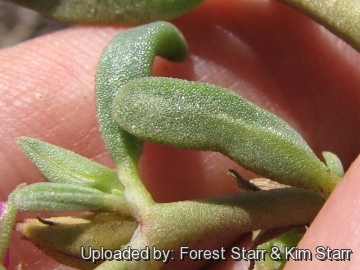 Leaves at Kealia Pond NWR, Maui, Hawaii, (USA). June 18, 2013. Photo by: Forest Starr & Kim Starr
Leaves at Kealia Pond NWR, Maui, Hawaii, (USA). June 18, 2013. Photo by: Forest Starr & Kim Starr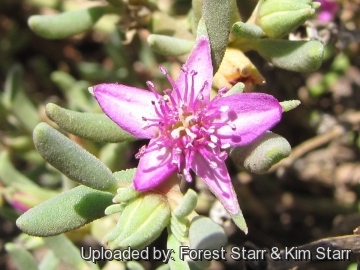 Flower at Kealia Pond NWR, Maui, Hawaii, (USA). June 18, 2013. Photo by: Forest Starr & Kim Starr
Flower at Kealia Pond NWR, Maui, Hawaii, (USA). June 18, 2013. Photo by: Forest Starr & Kim Starr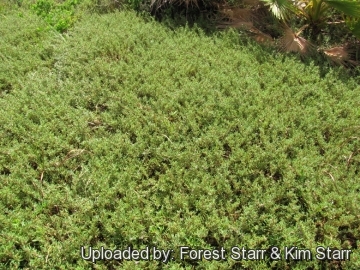 Habit at Kealia Pond, Maui, Hawaii (USA). July 03, 2013. Photo by: Forest Starr & Kim Starr
Habit at Kealia Pond, Maui, Hawaii (USA). July 03, 2013. Photo by: Forest Starr & Kim Starr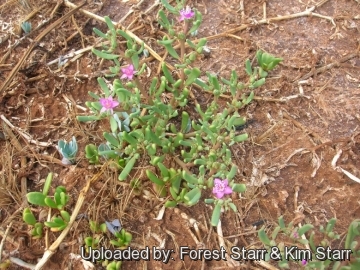 Habit at Kahului Airport, Maui, Hawaii (USA). July 21, 2006. Photo by: Forest Starr & Kim Starr
Habit at Kahului Airport, Maui, Hawaii (USA). July 21, 2006. Photo by: Forest Starr & Kim Starr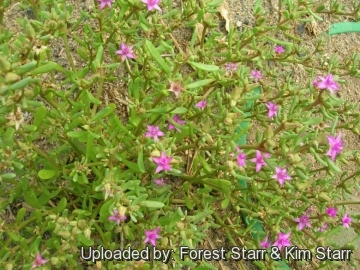 Flowers at Waiohuli Keokea, Maui. Hawaii (USA). September 02, 2005. Photo by: Forest Starr & Kim Starr
Flowers at Waiohuli Keokea, Maui. Hawaii (USA). September 02, 2005. Photo by: Forest Starr & Kim StarrSend a photo of this plant.The gallery now contains thousands of pictures, however it is possible to do even more. We are, of course, seeking photos of species not yet shown in the gallery but not only that, we are also looking for better pictures than those already present.
Read More... Cultivation and Propagation: The plants in this genus represent some of the more easily cultivated succulent species.
Water: Water moderately from early spring to the end of autumn, and keep the compost quite dry when the plants are dormant watering, only if the plant starts shrivelling (, but they will generally grow even in winter if given water). Outdoors does not require any supplemental water once established.
Soils: It grow in dry, moist or wet soils and can even grow directly in water. It adapt to almost every kind of substrate comprising: clay, sand, cinder, limestone, organic and coral either acidic, neutral and basic (alkaline).
Fertilization: It has low nutritional requirements and grows well in nutrient poor soils. But for an healthy cultivation follow a low fertilizing regiment (but this is not necessary for plants in water features) An application slow release fertilizer with minor elements every six months. Foliar feeding with a water-soluble or an organic fertilizer at one-third to one-fourth the recommended strength monthly has proved beneficial.
Exposure: Full sun is optimal but tolerates some shading for part of the day.
Salt Tolerance: It tolerates flooding by salt water and is a pioneer species that grows in unconsolidated substrate in direct salt wind and spray.
Hardiness: In areas prone to frost, grow in an intermediate greenhouse or conservatory, in pots of cactus compost. Provide maximum light all the year round.
Maintenance: Prune it to keep confined to growing areas.
Environmental recovery: Sesuvium verrucosumSN|28896]]SN|28896]] is one of the most salt-tolerant plants adapt to saline, semi-saline or alkaline habitats.
Gardening: It is an easy-to-grow groundcover, ideal for low-maintenance and water-wise gardens, for beach areas, saline soils, xeric landscaping and around water features where it does tolerate some foot traffic. But like most plants constant foot traffic will eventually cause irreparable damage. It is also a nice container plant that should be given full sun and regular watering.
Pests & disease: This prostrate groundcover is prone to slug and snail attacks.
Propagation: Seeds or cuttings. Seeds can be sown in early to mid-spring and germinated in heated humid environment. Alternatively, use stem cuttings taken towards the end of summer.















